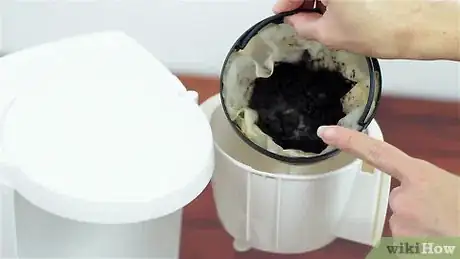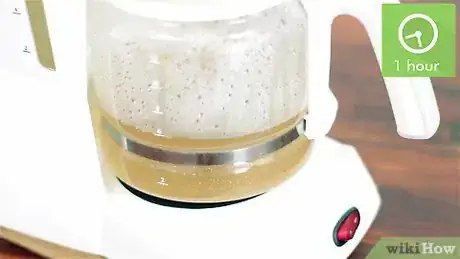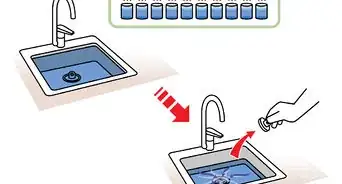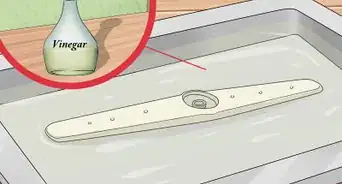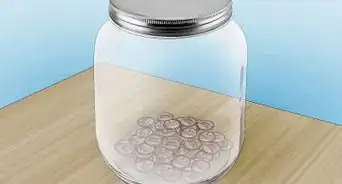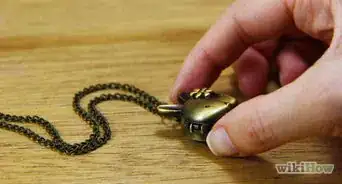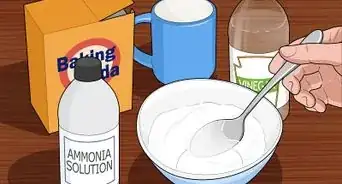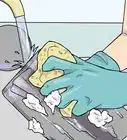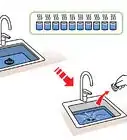This article was co-authored by Jonathan Tavarez and by wikiHow staff writer, Luke Smith, MFA. Jonathan Tavarez is the Founder of Pro Housekeepers, a premium cleaning service headquartered in Tampa, Florida catering to residential and commercial clients across the United States. Since 2015, Pro Housekeepers uses rigorous training methodologies to ensure high quality cleaning standards. Jonathan has over five years of professional cleaning experience and has over two years of experience as the Communications Director for the United Nations Association Tampa Bay. Jonathan earned a BS in Management and Marketing from the University of South Florida in 2012.
wikiHow marks an article as reader-approved once it receives enough positive feedback. In this case, 100% of readers who voted found the article helpful, earning it our reader-approved status.
This article has been viewed 472,183 times.
Nothing puts you off a fresh cup of coffee like a dirty coffee machine. Grime, sediment, and white calcification buildup just aren’t the best way to greet the day. Thankfully, a bit of white vinegar, water, and a little time can get that coffee machine sparkling again. We’ll show you how to mix the solution, run it through the machine, and rinse everything out to avoid a soapy, vinegary aftertaste.
Things You Should Know
- Mix equal parts water and white vinegar, then use it to run half of a brew cycle.
- Let the brewed vinegar solution sit in the pot for 1 hour, and then run the other half of the brew cycle.
- Pour the vinegar solution into the sink, then run 3 brew cycles using clean water to rinse out the machine.
- Wipe down the outside of the machine with a damp rag, and scrub the carafe with warm water and soap.
Steps
Mixing the Vinegar Solution
-
1Remove the filter and any coffee grounds. Empty the carafe of any remaining coffee grounds. Throw away the used filter if you haven’t done so already. Pour out any remaining water from a previous brew.[1]
- If you’d rather not throw out your coffee grounds after every pot, compost them and use them in your garden later—coffee grounds are a great source of supplemental nutrients for plants.
-
2Wash the carafe with soap and rinse the basket under warm water. Use a sponge, warm water, and soap to scrub the carafe clean. Then, make sure there aren’t any coffee grounds stuck inside of the basket filter. If there are grounds, wash the basket with soap and then rinse it with water. Place the basket back in the coffee maker when all of the grounds have been removed.[2]
- Wash your coffee maker after each use with soap and warm water to keep it clean and ready for the next pot of coffee.
Advertisement -
3Mix a solution of 1 part white vinegar and 1 part water. Combine the white vinegar and water in the carafe, and use a fork or other utensil to whisk them together. Don’t use more vinegar than water; too much vinegar can damage the internals of your coffee maker.[3]
- If your machine’s manual has a cautionary note about using vinegar, or you’re hesitant to use that much vinegar, dilute the mixture to 1 part vinegar to 3 parts water to weaken the mixture.
- Alternatively, use a mixture of 1 part water and 1 part lemon juice. [4]
-
4Pour the vinegar solution into your coffee maker’s reservoir. If the mixture doesn’t fill the reservoir all the way, mix more of the solution—enough to top it off so that you can run a few cycles through the machine.
Cleaning the Coffee Maker
-
1Brew half a pot of the mixture. Press the brew button once the vinegar solution is in the reservoir. Watch the coffee maker as it brews to avoid it completing the cycle. Turn off the coffee maker halfway through the brew cycle, when the carafe is halfway full.[5]
- If your coffee machine has it, use the built-in clean cycle instead (which typically has a dedicated button). An automated clean cycle usually starts and stops intermittently, allowing different parts of the machine to soak in the solution.
-
2Let the coffee maker sit for 1 hour. This allows time for the vinegar solution to tackle any mineral and mold buildup. If you don’t have an hour, let it sit for 30 minutes, or simply run 2 complete brew cycles, pouring the dirty water in the carafe into the sink between each cycle.[6]
-
3Finish the brewing cycle. Turn on the brew function again after 1 hour. Let the rest of the solution brew through the coffee maker.[7] You may see brown or white bits in the water. This is normal and means the vinegar solution is doing its job, removing residue from within the machine.
- Use this same method to clean a Keurig coffee maker—just brew the vinegar solution directly into a mug 3-5 times, discarding the brewed liquid after each cup.
Rinsing the Coffee Maker
-
1Pour out the vinegar solution and rinse the carafe with warm water. After the coffee maker has finished the complete brewing process, pour the solution down the sink drain. It’s okay if there are still remnants of the solution left in the coffee maker. Fill the carafe halfway with warm water and swish it around, then pour the water down the sink to flush out any particulate.[8]
-
2Fill the coffee machine reservoir with clean water. After you’ve rinsed it, pour fresh water into the carafe, and then pour it from the carafe into the coffee machine’s reservoir. Don’t use any more vinegar—we’re simply flushing the coffee machine out now. Use the maximum amount of water the coffee maker can brew.[9]
-
3Run the brew cycle 3 full times. Press the brew button to run a cycle with just water. Allow the entire brew cycle to run. Then, repeat the brew cycle 2 more times, pouring the brewed water into the sink and refilling the reservoir between each cycle. Let your coffee maker cool down for 3 to 5 minutes between the cycles.[10]
- Repeat 1 to 2 more brew cycles with warm water if you can still smell vinegar.
EXPERT TIPJonathan Tavarez is the Founder of Pro Housekeepers, a premium cleaning service headquartered in Tampa, Florida catering to residential and commercial clients across the United States. Since 2015, Pro Housekeepers uses rigorous training methodologies to ensure high quality cleaning standards. Jonathan has over five years of professional cleaning experience and has over two years of experience as the Communications Director for the United Nations Association Tampa Bay. Jonathan earned a BS in Management and Marketing from the University of South Florida in 2012.Property Hygiene Enabler
 Jonathan Tavarez
Jonathan Tavarez
Property Hygiene EnablerOur Expert Agrees: After you clean your coffee pot with vinegar, run 3 cycles with water only, which will flush it out.
-
4Wash the outside of the coffee maker with soap and water. Pour out the water after the last brew cycle. Then, remove the carafe and basket from your coffee maker. Clean the entire surface of your coffee maker with a small drop of liquid soap applied to a damp microfiber cloth. Then rinse the cloth and wipe down the machine again to remove any soap residue.[11]
- Alternatively, use a spray bottle to spritz the outside of the machine with pure white vinegar, then wipe it down with a microfiber cloth and rinse it with a damp paper towel, for a more thorough clean.
- Also wipe down the hot plate—just give it 30 minutes to 1 hour to cool down, first!
- Use a Q-tip to clean heard-to-reach places, like corners or metal detailing.
-
5Wash the coffee pot and basket to remove any vinegar residue. Hand wash the coffee pot and basket or put them into the dishwasher. To wash by hand, pour some dishwashing soap onto a sponge or rag. Scrub the entirety of the pot and basket. Then, rinse it with warm water. If you’re using the dishwasher, select the gentle cycle for the pot and basket.[12]
-
6Reassemble your coffee maker. Check to make sure there aren’t any remnants of mold or mineral buildup left, and scrub them away with a sponge if there are. Then replace the carafe and basket when you’re done cleaning. You’re ready to brew a fresh cup of coffee![13]
Community Q&A
-
QuestionThe single serving mechanism is clogged and will not feed water from the reservoir. I have used the needle process for cleaning the spout. That isn't the problem. It is clogged somewhere else.
 wikiHow Staff EditorThis answer was written by one of our trained team of researchers who validated it for accuracy and comprehensiveness.
wikiHow Staff EditorThis answer was written by one of our trained team of researchers who validated it for accuracy and comprehensiveness.
Staff Answer wikiHow Staff EditorStaff AnswerIf your machine is clogged or fails to brew coffee, you may need to take it in for repairs or replace it.
wikiHow Staff EditorStaff AnswerIf your machine is clogged or fails to brew coffee, you may need to take it in for repairs or replace it. -
QuestionCan I clean the machine with cleaning vinegar?
 wikiHow Staff EditorThis answer was written by one of our trained team of researchers who validated it for accuracy and comprehensiveness.
wikiHow Staff EditorThis answer was written by one of our trained team of researchers who validated it for accuracy and comprehensiveness.
Staff Answer wikiHow Staff EditorStaff AnswerYes! As long as the vinegar is white (transparent, no color) and you dilute it with water beforehand.
wikiHow Staff EditorStaff AnswerYes! As long as the vinegar is white (transparent, no color) and you dilute it with water beforehand. -
QuestionIs distilled white vinegar distilled with 5% acidity okay to use?
 wikiHow Staff EditorThis answer was written by one of our trained team of researchers who validated it for accuracy and comprehensiveness.
wikiHow Staff EditorThis answer was written by one of our trained team of researchers who validated it for accuracy and comprehensiveness.
Staff Answer wikiHow Staff EditorStaff AnswerYes! So long as the vinegar is white and diluted with water, it's safe to use in your machine. Use 1 part vinegar and 3 parts water if you worry the vinegar might damage the machine.
wikiHow Staff EditorStaff AnswerYes! So long as the vinegar is white and diluted with water, it's safe to use in your machine. Use 1 part vinegar and 3 parts water if you worry the vinegar might damage the machine.
Warnings
- Not cleaning your coffee maker at least once every six months could cause it to be filled with mold and bacteria.⧼thumbs_response⧽
Things You'll Need
- Water
- Distilled white vinegar
- Dish washing soap
- Sponge
- Rag or microfiber cloth
References
- ↑ https://www.thekitchn.com/how-to-clean-a-coffee-maker-cleaning-lessons-from-the-kitchn-200908
- ↑ https://www.thekitchn.com/how-to-clean-a-coffee-maker-cleaning-lessons-from-the-kitchn-200908
- ↑ https://www.thekitchn.com/how-to-clean-a-coffee-maker-cleaning-lessons-from-the-kitchn-200908
- ↑ https://www.architecturaldigest.com/story/how-to-clean-coffee-maker
- ↑ https://www.insider.com/guides/kitchen/how-to-clean-coffee-maker
- ↑ https://www.insider.com/guides/kitchen/how-to-clean-coffee-maker
- ↑ https://www.insider.com/guides/kitchen/how-to-clean-coffee-maker
- ↑ https://www.insider.com/guides/kitchen/how-to-clean-coffee-maker
- ↑ https://www.thekitchn.com/how-to-clean-a-coffee-maker-cleaning-lessons-from-the-kitchn-200908
About This Article
To clean a coffee maker with vinegar, first empty the carafe and any coffee grounds in the filter. Then, fill the water chamber with equal parts white vinegar and water, and run a brew cycle. Halfway through the cycle, turn your coffee maker off. Let it sit for 1 hour so the vinegar has time to clean it. Then, turn your coffee maker back on and let it finish the rest of the brew cycle. Dump out the vinegar and water solution and refill the water chamber with fresh water. Finally, run another brew cycle, then repeat 2 more times to ensure all of the vinegar is gone. If you want to learn how to use vinegar to clean the outside of your coffee maker, keep reading the article!
